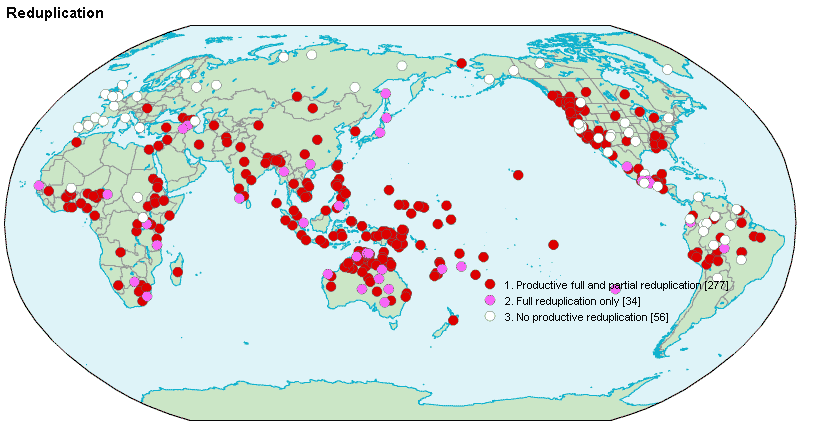Reduplicated
nouns certainly existed in Proto-Indo-European, but they are a poorly
investigated species. I will leave aside onomatopoeic reduplication, when the
echo consists of at least a CVC sequence, as in Proto-Slavic *golgolъ ‘speech’, Greek bárbaros ‘foreign’
(that is, speaking incomprehensibly), Latin murmur (no gloss necessary), or when the
whole stem is repeated, as in Hittite harsiharsi- ‘thunderstorm’. There
is a more interesting type in which reduplication is “grammatical” rather than purely
iconic, the echo template is CV, and only the consonant is copied from the
base. The showcase specimen is the celebrated word for ‘wheel’, *kʷékʷlos. It is not attested in the Anatolian subfamily,
so its Proto-Indo-European status is uncertain, but it dates back at least to
the common ancestor of Core Indo-European.¹
 |
| A Bronze Age sun chariot [source: the National Museum of Denmark, Copenhagen] |
The ‘wheel’ word is interesting for several reasons. Not all of them need to concern us here. Wheeled transport (in combination with horse domestication) is supposed to have played a crucial role in the early migrations of the Indo-European-speakers, and consequently in the expansion of the Indo-European languages. The appearance of a “technological package” containing terms for ‘wheel’, ‘axle’, ‘cart/wagon’, etc. marks the onset of these historical processes. But I shall concentrate on the linguistic properties of the word, not its cultural importance. The latter is relevant only as an “ecological” factor favouring the frequent use of the word, its successful survival and rich attestation.
*kʷékʷlos is an
original masculine – or, if it dates back to Proto-Indo-European after all, an
animate, non-neuter noun. One
of its forms is conspicuous by its unusually high survival rate – the
collective *kʷəkʷláh₂ (see below for details of the reconstruction). It must have been used very
frequently, for it tends to occur instead of the expected masculine plural. In Homeric
Greek, for example, kúklos has an irregular plural, kúkla (as if the word were neuter rather than masculine). This
is quite striking, because the use of the old PIE collective with animate
nouns, still productive in Old Hittite, became extremely rare in Core IE. The collective, co-opted already in PIE as the ordinary nominative/accusative plural
of the neuter gender, came to be associated exclusively with neuters in most daughter languages. Wheels, however, are more often spoken of as fixed sets (the two wheels of a chariot, the four wheels of a wagon) than as an
arbitrary number of individual objects. The fact that *kʷəkʷláh₂ is preserved so
well shows that the word was applied to wheels as vehicle parts when the
collective was still a living grammatical category, contrasting with the count
plural.
Let’s take *kʷékʷlos apart into its morphological
constituents: *kʷe-kʷl-o-s. The core part is *-kʷl-, in which we can recognise
the very common verb root *kʷelh₁- ‘move round, follow one’s course’ (with a
variety of secondary meanings, such as ‘become, stay around, inhabit, observe, cultivate,
take care of’ and the like). The
phonetic reduction of the root, resulting in the loss of the laryngeal segment
*h₁, is a normal phenomenon in compounds and reduplications. The reduplicated
noun is thematic (has a stem ending in the vocalic suffix *-o-), which suggests
adjectival origin. Collectives of o-stems were formed by adding the *-h₂ suffix
to the stem-final vowel in the e-grade: *-e-h₂ → *-ah₂. If the singular had
initial accent, the collective was accented on the ending (*-áh₂). This accent
shift happened early enough to affect the vocalism of some nouns (from a sufficiently old lexical stock). It is therefore probable that the collective
was *kʷəkʷláh₂, with a weak prop-vowel rather than a full-grade *e in the first
syllable. This would explain the development of the word in Greek: *kʷəkʷ- >
*kukʷ- (with the prop-vowel “stealing” lip-rounding from the preceding
labiovelar) > kuk- (with a regular delabialisation of *kʷ after /u/).
As the
accentual difference between the singular and the collective became
non-productive, the paradigm was levelled out in various ways to eliminate the
mismatch; that is why the accent is consistently initial in Greek (generalised from the
singular) and consistently final in Vedic (from the collective).
Since *kʷ(e)kʷláh₂ looks like a neuter plural, speakers were tempted to supply an
innovated neuter singular to match, *kʷ(e)kʷlóm, instead of the inherited
masculine (hence e.g. Vedic cakrám beside much rarer cakrás). The function of the “echo”
prefix *kʷé-/*kʷə- isn’t entirely clear, but judging from cross-linguistic
tendencies we can speculate that reduplication gave the underlying verb root an
iterative colouring (‘go round and round and round’ rather than ‘complete a turn’).
While rare,
the derivational pattern visible in the ‘wheel’ word (a thematic noun formed from a reduplicated verb
root) is not isolated, and can be found also on the Anatolian side of
the oldest split in the Indo-European family-tree. For example, the Hittite
word for ‘rake’ was hah(ha)ra-, plausibly reconstructed as *h₂áh₂ro- ← *h₂e-h₂rh₃-o-.
Here the root is *h₂arh₃- ‘break the soil, plough’, as in Greek aróō, Proto-Slavic *orjǫ, Old English erian
(all meaning ‘to plough’), or in the widespread Neo-Indo-European instrument noun *h₂árh₃-trom ‘ard, plough’ (Greek árotron, Old
Norse arðr).
The
behaviour of the ‘wheel’ word in Germanic so interesting and instructive that it deserves to be covered in a separate post (to appear soon).
[REDUPLICATION: back to the table of contents]
[REDUPLICATION: back to the table of contents]
———
¹ My use of the terms “Core Indo-European” and “Neo-Indo-European” is explained here.
² Of course the restoration of *e on the analogy of the singular was possible, and it certainly happened in some branches of Indo-European.
³ Note the semantic development in Tocharian, where *kʷékʷlos > Toch.A kukäl, Toch.B kokále came to mean ‘wagon, chariot’.









